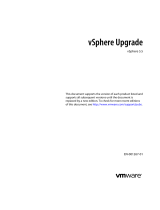
Contents
1 EVO:RAIL setup checklist.....................................................................................5
2 EVO:RAIL Appliance..............................................................................................7
Hardware................................................................................................................................................7
Workstation or laptop (for configuration and management)............................................................10
Automatic Scale-out........................................................................................................................... 10
Fault-tolerance....................................................................................................................................10
Logging in and Log Bundles............................................................................................................... 10
Out-of-band management (optional).................................................................................................11
3 Networking.......................................................................................................... 12
Top-of-Rack (TOR) switch..................................................................................................................12
IP Addresses and VLANs......................................................................................................................13
Network services................................................................................................................................. 14
Networking best practices.................................................................................................................. 14
4 Deployment, configuration and management............................................. 16
EVO:RAIL Deployment ....................................................................................................................... 16
EVO:RAIL Configuration...................................................................................................................... 17
Configuration Walk-Through........................................................................................................18
EVO:RAIL Management.......................................................................................................................22
Adding appliances to an EVO:RAIL cluster ..................................................................................23
Creating Virtual Machines.............................................................................................................24
Security Policies............................................................................................................................ 24
Monitoring VMs............................................................................................................................. 25
Monitoring Health......................................................................................................................... 26
Logging, Licensing, Updating, and Selecting Language..............................................................26
5 Appendix A: Network configuration table.....................................................28
EVO:RAIL default configuration table................................................................................................ 29
JSON configuration file format and valid values................................................................................31
6 Appendix B: Physical requirements................................................................ 34
7 Appendix C: EVO:RAIL Appliance Customization.........................................35
Customization of the initial management VLAN ID for EVO:RAIL.................................................... 35
Customizing the ESXi Management Network....................................................................................35
Customizing the VM Network............................................................................................................ 35
3






















